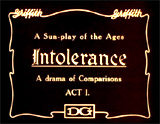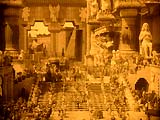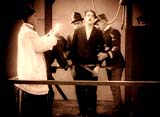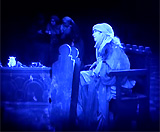
|
Intolerance
(1916)
In D. W. Griffith's epic silent film classic, with epic-sized
sets, especially in the ancient "Fall of Babylon" segments
- it was Griffith's expensive, most ambitious silent film masterpiece,
and one of the milestones and landmarks in cinematic history:

|

|
THE BABYLONIAN STORY
(539 B.C.) in the time of King Belshazzar
|
THE 'MODERN' STORY
(A.D. 1914) in America
|

|

|
THE FRENCH STORY
(A.D. 1572) in Huguenot France
|
THE JUDAEAN STORY
(A.D. 27) during Jesus' time in Jerusalem
|
- the four widely separate, yet paralleled stories
set in different ages - and in the original print, each story was
tinted with a different color
- the Mountain Girl's (Constance Talmadge) unsuccessful
and futile efforts to avert the attack of Persian King Cyrus upon
Prince Belshazzar (Alfred Paget); during a prolonged death scene,
the Mountain Girl crawled toward the Prince, her hero, to be next
to him, and then died at the base of a statue near the throne; an
iris opened, revealing the toy chariot pulled by two white doves
next to her body
- the exciting last-minute rescue of the Boy (Robert
Harron) from being hanged with the delivery of a pardon by his wife,
the Dear One (Mae Marsh) in the early 20th century America segments,
and his heart-warming reunion with her at the bottom of the scaffold
- the innovative finale - an overwhelming, rhythmic,
conglomerate sequence which placed all four stories into a stirring,
fast-moving and exciting climax - as the suspenseful drama began
to conclude, the cross-cutting increased in tempo and rapidity with
shorter and shorter segments of each tale flowing together
- and the recurrent, interwoven image of a mother (Lillian
Gish) endlessly rocking a cradle, the film's final medium-close shot
- accompanied by the title from Walt Whitman's poem Leaves of
Grass: "Out of the Cradle Endlessly Rocking. Uniter of Here
and Hereafter - Chanter of Sorrows and Joys."
|

Mountain Girl


Rescue of the Boy From Hanging

Recurring Cameo Image of Mother
|





